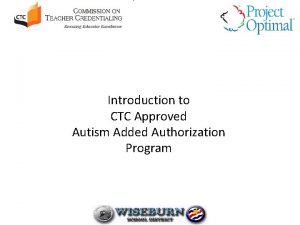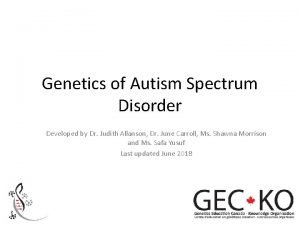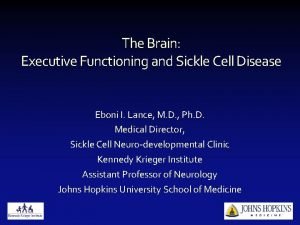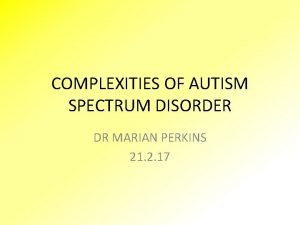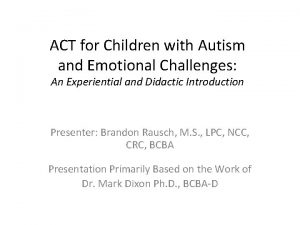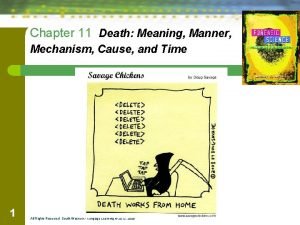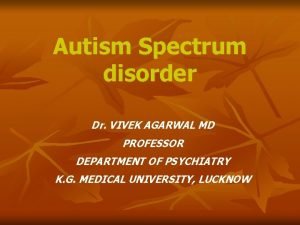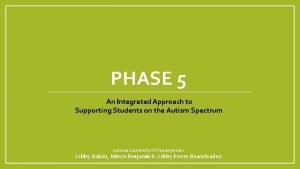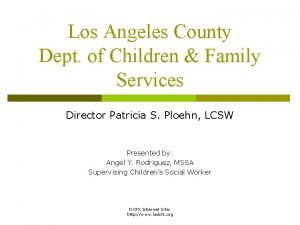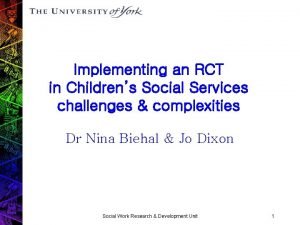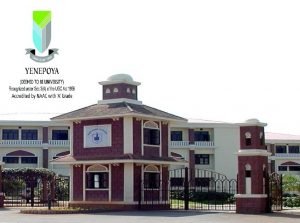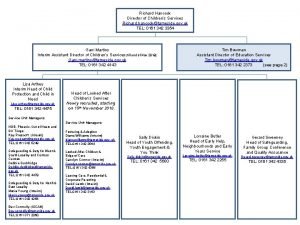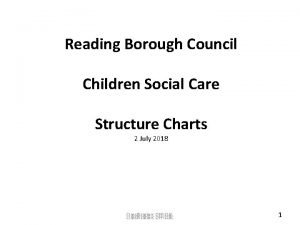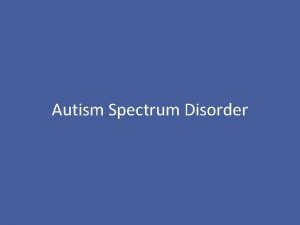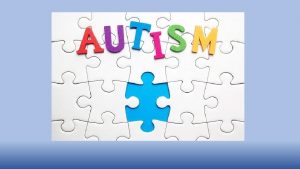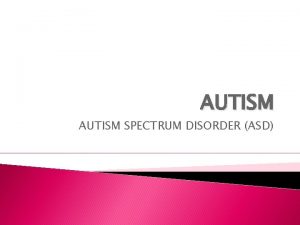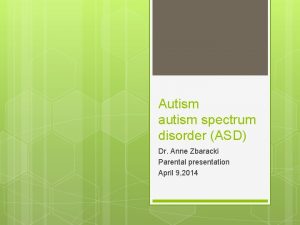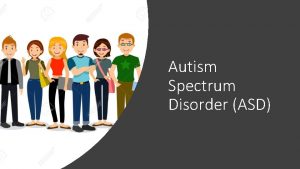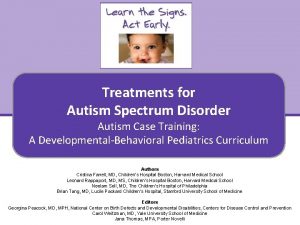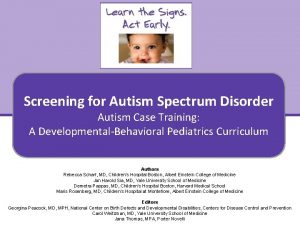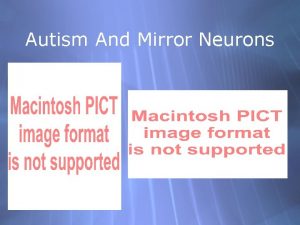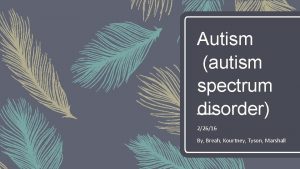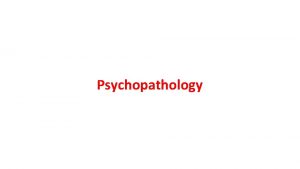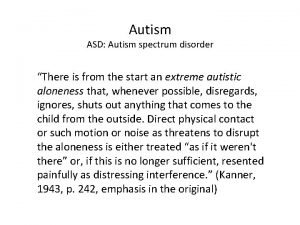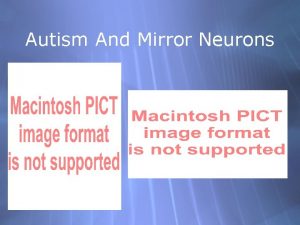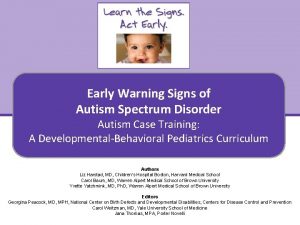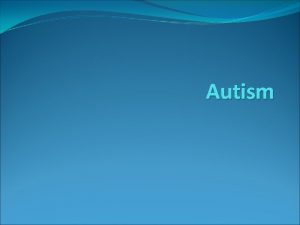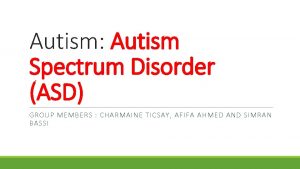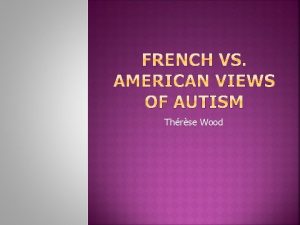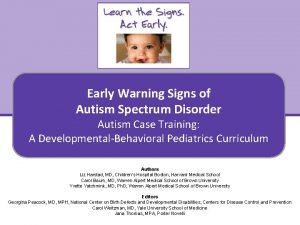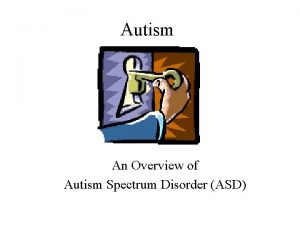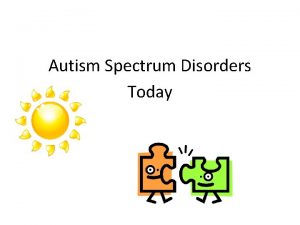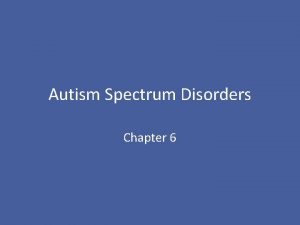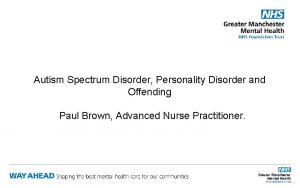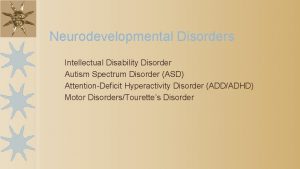MediCal Services for Children with Autism Spectrum Disorder

























- Slides: 25

Medi-Cal Services for Children with Autism Spectrum Disorder & the Family Focused Model of Care Clayton Chau, MD, Ph. D Regional Executive Medical Director, Institute for Mental Health & Wellness, Providence St Joseph Health Associate Clinical Professor of Psychiatry, UCI Medical School Clayton. Chau@stjoe. org

Agenda • Early and Periodic Screening Diagnostic and Treatments (EPSDT) and Mental Health Services for Medi-Cal Children • Autism Spectrum Disorder (ASD) • The referral process and eligibility for Behavior Health Treatments for ASD • The Family Focused Model of Care

Early and Periodic Screening, Diagnostic and Treatment • Section 1905(a)(4)(B) of the Social Security Act (SSA) for Early and Periodic Screening, Diagnostic and Treatment services (EPSDT) – Comprehensive array of preventive, diagnostic and treatment for low-income infants, children and adolescents under 21 years of age. – States are required to provide any Medicaid covered service listed in Section 1905(a) of the SSA that is determined to be medically necessary to correct or ameliorate any physical or behavioral conditions. – The EPSDT benefit is designed to ensure • that children receive early detection and preventive care • medically necessary treatment services

Adolescent BH Care – Health Plans • EPSDT for children under age 21, health plans must provide a broad range of medically necessary services that is expanded to include necessary health care, diagnostic services, treatment to correct or ameliorate defects and physical and mental illnesses and conditions discovered by the screening services, whether or not such services or items are covered under the state plan (DHCS APL 14 -017) • Beginning September 2014, Behavioral Health Treatment/Applied Behavior Analysis (ABA) was added to health plan benefit under EPSDT • Therapeutic Behavioral Services (TBS) and specialty mental health services are available from county DMH • SUD treatment services are available under Drug Medi-Cal 4

Adolescent BH Care – County • • EPSDT for children under age 21, county mental health plans shall provide or arrange for the provision of specialty mental health services (SMHS) for all Medi-Cal beneficiaries that meet medical necessity criteria for SMHS regardless whether or not they are enrolled in a health plan (MHSUDS Info notice 16 -061) The determination of medical necessity for SMHs is based on an assessment of the beneficiary by the county mental health plan For children and youth, under EPSDT, the “impairment” criteria component of SMHS medical necessity is less stringent than it is for adults, therefore children with low levels of impairment may meet medical necessity criteria for SMHS (CA Code Reg, Tit 9, 1830. 205 and 1830. 210) To receive SMHS, Medi-Cal children and youth must have a covered diagnosis and meet the following criteria: 1. 2. Have a condition that would not be responsive to physical health care based on treatment; and The services are necessary to correct or ameliorate a mental illness and condition discovered by a screening conducted by the health plan, the Child Health and Disability Prevention Program, or any qualified provider operating within the scope of his or her practice, as defined by state law regardless of whether or not that provider is a Medi-Cal provider 5

6

Check in | 7

What is Autism? • Autistic disorder • Childhood disintegrative disorder • Pervasive developmental disorder-not otherwise specified (PDD-NOS) • Asperger syndrome. DSM-5 Autism Spectrum Disorder (ASD)

Epidemiology of ASD • Prevalence – 1 in 68 children, and 1 in every 42 boys will be diagnosed with ASD (Centers for Disease Control (CDC), 2014). – 78 % increase in ASD diagnosis between the years of 2002 and 2008 (CDC, 2014). – Gender Differences (Mash, & Barkley, 2014) • 4: 1 male to female ratio • Males, compared to females, are 8. 8 times more likely to have intellectual ability within the average range • Females with average IQ tend to show less symptoms of Autism than boys with similar IQ levels

Epidemiology of ASD – Age of Diagnoses • The median age of diagnosis is 44 months (CDC, 2014) – Epidemiological studies suggest that there are no differences by race or ethnicity in the actual prevalence or incidence of Autism (Bertrand et al. , 2001; Mash, & Barkley, 2014). – Cultural Factors (CDC 2014; Emerson, Morrell, & Neece, 2016). • Caucasian children are approximately – 30% more likely to be identified with ASD than non. Hispanic black children – 50% more likely to be identified with ASD than Hispanic children.

Referral and Diagnoses • PCP’s screening yields positive or concerning results 1. PCP refers the child to a Regional Center that services the area in which the family resided for Comprehensive Diagnostic Evaluation (CDE) Ø Regional Centers Ø Non-profit Corporations that contract with D. D. S. Ø 21 Regional Centers in California Ø 7 Regional Centers in Los Angeles County 2. If the child is 2. 5 years of age or older the caregiver should be referred for special education eligibility assessment as well

Referral and Diagnoses Regional Center Completes the CDE Indicates Diagnoses of ASD and BHT/ABA is recommended by a licensed psychologist or physician Member Contacts Health Plan to Request Behavior Health Treatment CDE does not indicates Diagnoses of ASD Member does not meet the Eligibility for BHT services

Comprehensive Diagnostic Evaluation Based on best practice guidelines: 1. Parent or caregiver interview 2. Review of relevant medical, psychological, and/or school records 3. Cognitive/developmental assessment 4. Direct play observation 5. Measurement of adaptive functioning 6. Comprehensive medical examination (by the primary care physician required under EPSDT) 7. Language assessment (could be by a speech language pathologist) 8. Sensory evaluation (could be by and occupational therapist) 9. If indicated, neurological and/or genetic assessment to rule out biological issues (by a developmental pediatrician, pediatric neurologist, and/or geneticist) 13

Behavior Health Treatment (BHT) • Eligibility for BHT services – All of the following coverage criteria must be met 1. Be under 21 years of age 2. Have a diagnosis of ASD 3. Have a recommendation that evidence-based BHT services are medically necessary i. a licensed physician and surgeon ii. a licensed psychologist 4. Be medically stable 5. Be without a need for 24 -hour medical/nursing monitoring or procedures provided in a hospital or intermediate care facility for persons with intellectual disabilities (ICF/ID)

Medi-Cal covered BHT services must be • Medically necessary as defined by Welfare and Institutions Code Section 14132(v). • Delivered in accordance with the beneficiary’s Managed Care Plan (MCP – Health Plan) approved behavioral treatment plan • MCP-approved behavioral treatment must be developed and supervised by a contracted (or other form of agreement between the MCP and provider) and MCP-credentialed “qualified autism service provider, ” as defined by H&S Code Section 1374. 73(c)(3). – Board Certified Behavior Analyst – Licensed psychologist, marriage and family therapist, educational psychologist, clinical social worker, professional clinical counselor

Medical Necessity Criteria From APL 14 -011: The following services do not meet medical necessity criteria, nor qualify as Medi-Cal covered BHT services for reimbursement: • Therapy services rendered when continued clinical benefit is not expected • Services that are primarily respite, daycare or Educational in nature and are used to reimburse a parent for participating in the treatment program • Custodial care: assist in daily living (bathing, dressing, eating, maintaining personal hygiene and safety) 16

APL Specific Guidelines and Timeline – The qualified autism service provider should offer to meet with the member to conduct an Functional Behavior Assessment (FBA), 15 days after the Health Plan makes its determination – The qualified autism service provider should offer to start the services, 15 days after the Health Plan makes its determination based on the FBA report. – Prior authorized Applied Behavior Analysis (ABA) services by the MCP for a time period do not exceed 180 days BHT services shall be rendered in accordance with the beneficiary’s treatment plan. The treatment plan shall: 1 - Be person centered and based upon individualized goal over a specific timeline 2 - Be developed by a qualified autism service provider 3 - Delineate both the frequency of baseline behaviors and the treatment planned to address behaviors 17

APL Specific Guidelines 4 - Identify long, intermediate and short term goals and objectives that are specific, behaviorally defined, measurable and based upon clinical observation 5 - Include outcome measurement assessment criteria that will be used to measure achievement of behavior objectives 5 - Using evidence based treatments 6 - Include care coordination involving parents or caretakers, school 7 - Include parent/caregiver training, support, and participation 8 - Clearly identify the service type, number of hours of direct hours and supervision, and parent participation necessary to achieve the plan’s goals and objectives, the frequency at which the progress is reported and individual providers responsible for delivering the services APL 14 -11 Page 5 -6 18

Established ABA Interventions for 22 and under (National Standards Project) • Behavioral Interventions • Cognitive Behavioral Intervention Package • Modeling • Natural Teaching Strategies • Pivotal Response Training • Schedules • Scripting • Story-based Intervention • Comprehensive Behavioral Treatment for Young Children • Language Training (Production) • Parent Training • Peer Training Package • Self-Management • Social Skills Package

Discontinuation of BHT Services • BHT services may be discontinued when – The treatment goals are achieved – Goals are not met; or – BHT is no longer medically necessary

Check in | 21

Association of Mental and Physical Health Supports Integration Care Mental illness is associated with chronic physical diseases CVD Diabetes Cancer Mental illness Epilepsy Obesity Mental illness is also associated with • Lower utilization of medical care • Reduced adherence to medication for chronic diseases • Increased risk of adverse health outcomes Asthma CVD, cardiovascular disease. Centers for Disease Control and Prevention. https: //www. cdc. gov/mentalhealthsurveilance/fact_sheet. html. Accessed March 30, 2017. 22 The information provided by Psych. U is intended for your educational benefit only. It is not intended as, nor is it a substitute for medical care or advice or professional diagnosis. Users seeking medical advice should consult with their physician or other healthcare professional. © Psych. U. All rights reserved.

Behavioral Health Model of Care for Children & Adolescents Community Based Human & Health Care Acute Behavioral Health Care Mental Health Unit Social Services Agency (Foster Care, Court, etc) Law Enforcement Pediatricians/ Primary Care Chemical Dependency Recovery Center Co-occurring Disorders Unit Family Focused Outpatient Clinics Children’s Hospital Home & Family Intensive Outpatient Programs School/ Vocational Rehab Neighborhoods Church/ Clergy Regional Centers/ CHDP Community Organizations & Family Resource Centers Partial Hospitalization Programs Transitional Living Center Residential Treatment Programs Behavioral Health Recovery & Rehab

Family-Focused Integrated Care Model • Care for the family • Mental Health, SUD and Primary Care Integration • Coordinate/linkage to community resources/programs • Same care team provided at different levels • “One Care Manager” 24

Q&A | 25
 Ctc added authorization
Ctc added authorization Asd levels
Asd levels Are there different types of autism
Are there different types of autism Spectrum disorder
Spectrum disorder Autism spectrum disorder adhd
Autism spectrum disorder adhd Social pragmatic communication disorder vs autism
Social pragmatic communication disorder vs autism Puberty and autism spectrum disorders
Puberty and autism spectrum disorders Act for children with autism and emotional challenges
Act for children with autism and emotional challenges Conversion vs somatic symptom disorder
Conversion vs somatic symptom disorder Fetal alcohol spectrum disorder
Fetal alcohol spectrum disorder Spectrum disorder
Spectrum disorder Spectrum disorder
Spectrum disorder Line spectrum and continuous spectrum difference
Line spectrum and continuous spectrum difference Absorption spectrum vs emission spectrum
Absorption spectrum vs emission spectrum Children and family services los angeles
Children and family services los angeles Rct children's services
Rct children's services Eyfs moodle hampshire
Eyfs moodle hampshire Agencies related to child welfare
Agencies related to child welfare All india women's conference was founded by
All india women's conference was founded by Richard hancock tameside
Richard hancock tameside Lorain county child protective services
Lorain county child protective services Reading borough council children's social services
Reading borough council children's social services Kontinuitetshantering i praktiken
Kontinuitetshantering i praktiken Typiska drag för en novell
Typiska drag för en novell Tack för att ni lyssnade bild
Tack för att ni lyssnade bild Returpilarna
Returpilarna
